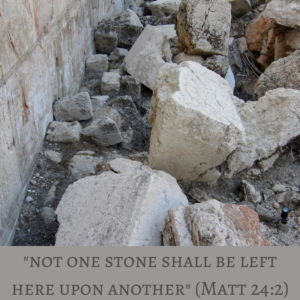
Our view of prophecy affects how we view the Lord’s model prayer and Great Commission. He taught us to pray for His kingdom to come and, toward that end, told us to make disciples of the nations. We cannot fully understand His meaning without an accurate understanding of biblical prophecy.
I’ve announced (here) my intention to develop an easy-to-understand framework to provide that awareness. In my last post (here), I proposed the Olivet Discourse as our starting point, and now, I want to do two things: examine its subject and the disciples’ two questions.
The Subject of the Olivet Discourse
Here are the opening words of this passage in Matthew, Mark, and Luke:
Then Jesus went out and departed from the temple, and His disciples came up to show Him the buildings of the temple. And Jesus said to them, “Do you not see all these things? Assuredly, I say to you, not one stone shall be left here upon another, that shall not be thrown down.” (Matt 24:1–2)
Then as He went out of the temple, one of His disciples said to Him, “Teacher, see what manner of stones and what buildings are here!” And Jesus answered and said to him, “Do you see these great buildings? Not one stone shall be left upon another, that shall not be thrown down.” (Mark 13:1–2)
Then, as some spoke of the temple, how it was adorned with beautiful stones and donations, He said, “These things which you see—the days will come in which not one stone shall be left upon another that shall not be thrown down.” (Luke 21:5–6)
The topic of discussion is Jesus’ prophecy about the temple’s destruction.1 This fact should guide our understanding of this passage unless He notifies us of a change in subject.
At first glance, this topic may seem unrelated to the Great Commission, but the relationship between them will appear as we move through this passage. The temple’s destruction would open the door to a new age of evangelism.
Jesus had prepared His disciples for this discussion by rebuking Israel for her sins throughout His ministry. He had uttered over thirty oracles of judgment against the apostate nation. He had adopted the message of John the Baptist, who warned Israel of the wrath about to come (Matt 3:7–12). Jesus had warned that God would soon cast Israel out of His kingdom (Matt 8:11–12).
The frequency and intensity of these declarations had increased during His earthly ministry, reaching their climax in the week of Jesus’ death. The day before He gave the Olivet Discourse, Jesus had cursed a fig tree, a well-known symbol of Israel (Matt 21:18–22). He told a parable of a landowner and his tenants to show God would take the kingdom from Israel (Matt 21:33–46). In a parable about a marriage feast (Matt 22:1–14), Jesus spoke of armies coming to destroy Israel and burn Jerusalem (Matt 22:7). He warned them that God would avenge the blood of all the prophets on their generation and leave their house (the temple) desolate (Matt 23:31–39).
So, the Olivet Discourse (beginning at Matthew 24:1) is the capstone of Jesus’ condemnation of apostate Israel. A single subject—the temple’s fall—controls its progress. We must not allow preconceived ideas to divert our attention from this fact.
Two Questions in the Olivet Discourse
Jesus’ prophecy about the temple’s destruction provoked two questions from the disciples: (1) When will it happen? and (2) What signs will lead up to it? Understanding these queries will help us comprehend the Lord’s Prayer and the Great Commission He gave about six weeks later.
Here are the three versions of the questions as recorded in the gospels:
Now as He sat on the Mount of Olives, the disciples came to Him privately, saying, “Tell us, when will these things be? And what will be the sign of Your coming, and of the end of the age?” (Matt 24:3)
Now as He sat on the Mount of Olives opposite the temple, Peter, James, John, and Andrew asked Him privately, “Tell us, when will these things be? And what will be the sign when all these things will be fulfilled?” (Mark 13:3–4)
So they asked Him, saying, “Teacher, but when will these things be? And what sign will there be when these things are about to take place?” (Luke 21:7)
Jesus answers both questions in reverse order from how the disciples asked them. But before we examine His response, I want to make an important point: these two questions relate to the things concerning the temple’s destruction, nothing more. To show this, I want to compare the questions as they appear in the gospels. I’ll begin by isolating the when question:
When will these things be? (Matt 24:3)
When will these things be? (Mark 13:4)
When will these things be? (Luke 21:7)
The gospel writers record this question with striking uniformity. Jesus said the temple would fall; the disciples asked when “these things”—events surrounding the temple’s destruction—would occur. They did not ask about the end of the church age, the climax of history, the collapse of the physical universe, or anything else; they wanted to know when the temple would fall.
Conclusion
The Olivet Discourse will furnish the foundation for a simplified framework of prophecy. Here are two takeaways from this post: (1) Jesus’ subject is the temple’s fall, and (2) the disciples’ when question reinforces this observation—they wanted to know when “these things” related to the temple would take place.
Simple, huh?
Footnotes
- The image in this post is of stones knocked onto the street below by Roman battering rams on the 9th of Av in AD 70. The file is here and is in the public domain (PD-US).
